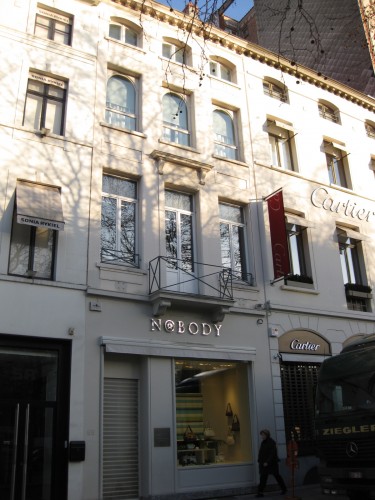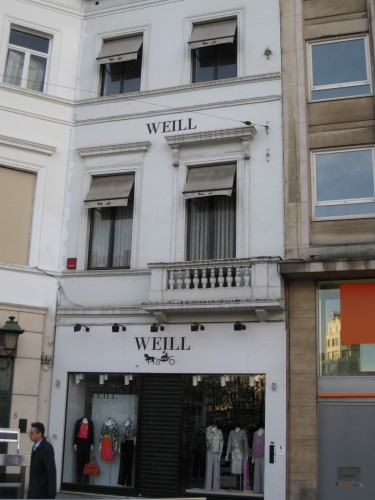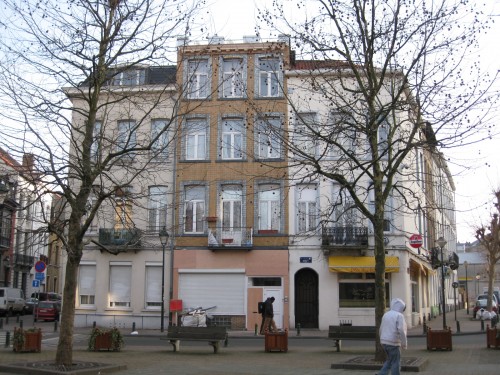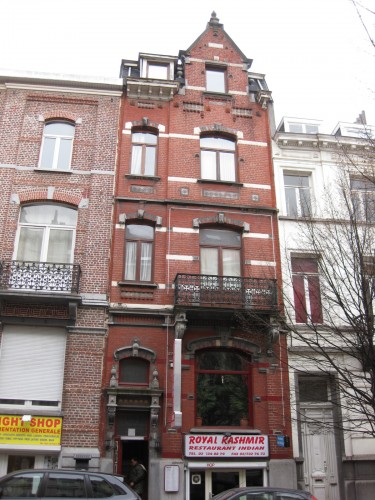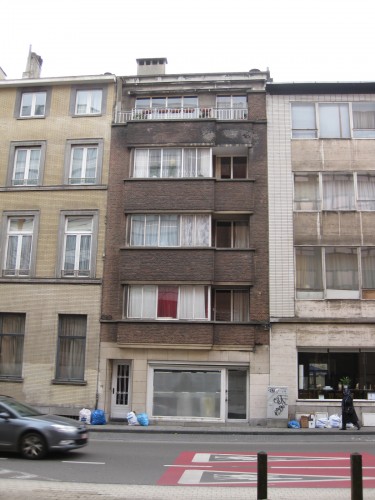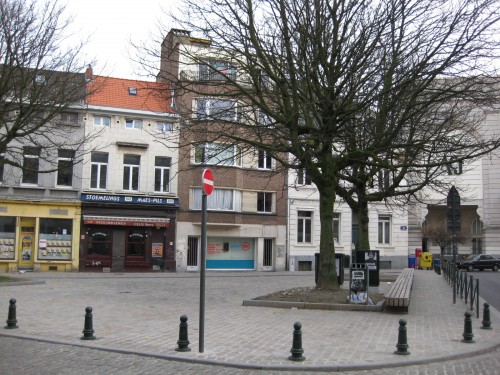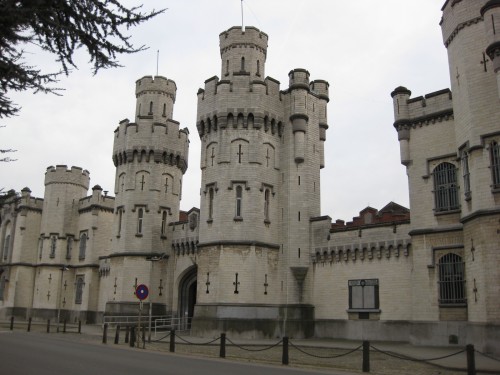Searching for the Dutch-Paris Escape Line
Attitudes Have Changed in the Last 20 Years…
Twenty years ago I wanted to write my dissertation on the Resistance but everyone from professors to archivists told me it could only be done as an oral history. My French couldn’t stand up to that, so I found another topic (the Liberation). I think everyone was right at the time, but it wasn’t that the documents for the Resistance didn’t, in theory, exist; it was that you couldn’t get at them if they did.
Back then, any document having to do with the period 1940-1945 in any French archive could only be consulted by permission of the prefecture of the department, the ministry of culture and the police. You had to request such permission for each individual dossier by its inventory number. The inventories, such as they were, were kept under lock and key in the archivists’ offices. You had to gather your credentials, preferably affixed with a large seal, and beg. One departmental archivist told me that I couldn’t see the inventories because there was already a book about the war in the department. Apparently she didn’t think there was any need of another. I said thank you and moved on to the neighboring department where the (younger) archivist let me see the inventories, but warned that the topic was “un peu délicat” (a tad delicate). In the course of time, Read the rest of this entry »
- 0 Comments
- Tags: France
Sitting in the archives of CEGES/SOMA in Brussels, I opened up a folder piled high with official forms all neatly filled out by hand or typewriter in bureaucratic German. They were the files of the Devisenschutzkommando (DSK), literally translated as the Currency Protection Unit*. It sounds innocuous enough, like a band of accountants searching out money laundering schemes by studying account books. Indeed, they answered to the German customs authorities. But they were far from innocuous. They were hunting for loot and although some of their victims were “Aryans”, most were Jewish.
One random report states that in Brussels on 23 October 1942 the officer arrested a Jewish couple making an illegal journey from Holland to Switzerland. He confiscated the following:
258 Dutch guilders in notes
140 US dollars in notes
20 Swiss francs in notes
23 Swiss francs in silver
The DSK also arrested Jews who lived in Brussels while plundering their homes. Lists of confiscated valuables make up the bulk of the reports. And then, almost as an after thought, comes the sentence: the Jews in question were turned over to the SS or SD. Which meant deportation, which was as good as writing out a death warrant.
What’s so chilling about these documents is the orderly greed of it. The point was the theft of the money and other valuables. The murders were secondary, almost a way of closing the book on the account, making sure that the balance stayed on the Reich’s side.
*CEGES AA 558/110 a-c. For more on the nefarious activities of the DSK in Belgium, see the work of Insa Meinen (in French and German).
- 0 Comments
- Tags: arrests, Belgium, Jews
Just in case anyone thinks that the life of a researcher is glamorously exciting or satisfyingly contemplative, let me tell you about the day I had.
I started out from my hotel in Brussels at 7:30 am with the idea of photographing some of the places used by Dutch-Paris, known here as the Comité. Back in the Netherlands I had the idea of renting a bike to photograph all of them, but then I saw how people drive here.
The first place was the Café du Tunnel, 55 Boulevard de Waterloo. A woman who found hiding places for at least a hundred Dutch Jews during the war would meet one of the Comité and her latest “clients” here to take them to their hiding place. It’s now a high-end clothing shop.
Nearby at 6, Place Louise, was another café used as a rendez-vous that is now a high-end clothing shop. So much for breakfasting at the scene of clandestine meetings.
So I kept walking to 6 Heldenplein, home of the Comité’s pastor. I can only assume that the neighborhood was in better repair in the 1940’s. At least the name “heroes’ square” remains appropriate.
From there I walked over to Belgian’s Second World War archives and research institute, CEGES/SOMA. I could not have been more warmly welcomed there, but that’s no guarantee of satisfying research. I started out with some German documents that sounded better in the catalog description than they turned out to be, as is all too often the case in any archive. Then I looked at some superbly rich documents which were nevertheless disturbing in that they were essentially the preamble to the death warrants of innocent people. They cast a pall on the day, and they only went up to 1943 whereas I need them for 1944.
So I requested three more dossiers. The woman whose turn it was to fetch documents came to apologize to me in both Dutch and French that she couldn’t get any of them. One had disappeared (no great loss: they’re photocopies of reports in the archives of the foreign ministry). One was in the office of a researcher who wasn’t in today. And the third was a massive collection of an enormous Belgian Resistance network. The archivist in charge of them only began to catalog them a couple of weeks ago. It’s impossible to request files without a catalog number. She offered to go fetch the archivist, but I elected to send him an email on the subject.
I then came across a reference to the trial of Geheime Feldpolizei 530, the German secret police unit that arrested at least two and possibly more members of the Comité. I set off an alarm when I went to ask someone about where to find those records, but Madame, le président du salle, called yet another researcher about it. It turns out that I need to apply to the Ministry of Justice to see the trial records and the Ministry of Social Welfare to see the other reports regarding the prisons.
I need to write the Ministry of Social Welfare anyway to see their files on the 47 members of Dutch-Paris who were arrested by the Germans in Belgium. And I need to apply to the Sureté d’Etat (security services) to see the files they have about a dozen or so members of Dutch-Paris.
By this time it was noon, when the archive closes for an hour, and I’d reached an impasse. I decided to walk over to the Museum and Archives of the Flemish [Dutch-speaking] Community in Brussels. My mistake was to rely on the map. I did indeed find a buzzer labeled with the name of the museum, but the person who answered it spoke French. During the course of our second conversation over the intercom he explained in no uncertain terms that there was no archive in the building and that everyone there was French-speaking. I admit that it did seem like an unlikely building for a museum.
Being close to what I had thought was the address of the Dutch church in Brussels during the war, I tried to find that. And failed. So I took the metro to 19 rue Franklin, site of a German raid on 28 February 1944 (see previous blog entry on remembrance day). It’s now in the shadow of the European Union building, which of course wasn’t there in 1944. In fact, in 1944, European union was a rather unpopular idea of Hitler’s.
Having plotted all this out on Google maps, I caught a bus that would take me to the rue du Trone. Except that the bus went one stop; the driver shouted “Terminus!”, and everyone got out. I discovered that that bus takes a three-hour break on Wednesday afternoons. Fortunately I was back at the metro and managed to take it close enough to 73, rue du Trone, which was the Comité’s headquarters for “social work” ie hiding people. It wasn’t chosen for its beauty but it may have been chosen because it goes through to the Place du Londres on the back side instead of to the usual dead-end courtyard.
Then I took a very long, crowded and winding bus ride to the prison of St. Gilles where at least a dozen members of the Comité spent some time. Despite appearances, it was built in the late nineteenth century and looks the same today as it would have in 1944. I don’t know whether the Germans kept guards outside the gates or not.
From there I was able to take the metro and my feet, arriving back at the hotel at 5:30 pm. Was it a successful day? In terms of gathering citable information, no. But I’m now on the way to seeing what promise to be extremely useful documents. And I have a good sense of the distances that members of the Comité traveled by foot or public transport and a solid appreciation for the hills of Brussels.
- 0 Comments
- Tags: arrests, Belgium
Our Remembrance Day
In March 1951 a man (b. 1890) who had sheltered fugitives for Dutch-Paris in Brussels wrote a letter to John Henry Weidner about the group’s recent commemoration of “onze gedenkdag” on 28 February. Literally that means “our anniversary” but in this case it would be better translated as “our remembrance day.”
On the 28th of February 1944 German security services raided the pension at rue Franklin, 19, Brussels. What they found was the headquarters of the Belgian section of the Dutch-Paris pilot escape line, complete with ten American airmen, a fully-equipped atelier dedicated to producing false documents, and Dutch-Paris’s records and account books. They confiscated all the papers, presumably sent the Americans to POW camps, and arrested everyone in the building, including:
Mademoiselle O., the Belgian owner of the pension who did not survive deportation to a concentration camp.
“Jo Staal” – A Jewish man born in Berlin in 1921 but rendered stateless by the Nazis. He had brought pilots from Maastricht (Netherlands) through Brussels to Paris. After the liberation of Brussels freed him from the prison of St. Gilles, he fought with the British until being captured as a POW. He survived the war.
“Chris” – a young Dutch man who escorted people over the Dutch-Belgian border. The Allies liberated him from the prison camp at Beverloo in September 1944.
“Monsieur Hans” – A Jewish man born in Amsterdam in 1923. He had distributed false documents to people in hiding and escorted pilots to Paris. He was tortured five times before being transferred to the camp at Beverloo, where the Allies liberated him.
“Rob” – Born in 1923 in Alblasserdam (Netherlands) and a geology student, he had made fifteen trips to Paris with airmen between being recruited into Dutch-Paris in January 1944 and his arrest at the end of February. He was imprisoned in St. Gilles until August 1944, then transferred to the camp at Beverloo. After being freed, he joined the Dutch military intelligence services as a 1st lieutenant.
“Jan” – A law student at the faculty of law at Utrecht (Netherlands), where he was born in 1917. He made the false documents for Dutch-Paris. The Germans tortured him before he was transferred to the camp at Beverloo, where he was liberated in September 1944.
“Vermaas” – The youngest Dutchman to receive a law degree, he had been involved in a student organization to rescue Jewish children in Utrecht. He had come to Belgium to study economy and been in charge of daily operations for Dutch-Paris since November 1943. He threw himself over the staircase at the prison of St. Gilles on 10 March 1944 in order to take all the blame onto himself and so spare his colleagues. He died shortly thereafter at a military hospital. Monsieur Hans was not tortured again after Vermaas’s suicide.
This raid was only one incident in the “roll-up” of the line that is thought to have begun with the arrest of a courier in Paris on 11 February 1944. According to one list found among John Henry Weidner’s papers, Dutch-Paris suffered 33 arrests between 18 February and 18 March 1944 and a further 12 between 20 March and 7 April 1944. There were certainly more arrests, more deportations, more deaths.
But Dutch-Paris kept going. Others stepped up to deliver money and false documents to people in hiding, others escorted fugitives and gave them shelter. It was harder with all those losses, but the “goede zaak” (the good job) got done.
The 28th of February seems like a good day for all of us to remember those who fought the Nazi evil by showing mercy to its victims rather than by wielding weapons.
- 0 Comments
- Tags: arrests, Belgium, concentration camps
At the Nationaal Archief today I asked for a file regarding the repayment of loans made to Dutch-Paris during the war. The file belonged to the records of the Dutch Embassy in Belgium and I had to read it in the section of the archives with extra surveillance. A guard sits at the top of the steps leading to the area watching to make sure that no one makes any copies. And he is watching. I’ve seen the guards there take a pencil away because it had an eraser on it.
What, you might ask, is so secret about that file? There turned out to be something more in there than the correspondence about repaying those loans.
The biggest of the loans was for 2,000,000 Belgian francs made by a Dutch builder living in Antwerp on the collateral of a microfilmed guarantee signed by the Dutch Ambassador to Switzerland on behalf of the Dutch government-in-exile. The sheaf of notarized documents about that loan made the repayment of it clear cut. The Dutch Ambassador to Belgium gave the builder, we’ll call him van H, a check for 2,000,000 Belgian francs in February 1946.
In March 1946 the Dutch consul in Antwerp received a letter from our man in the construction business. It seems that on his own and without any receipts or lists of names, he handed out a further three and a half million francs to Dutchmen in distress during the war. And he helped Allied pilots. And he started in 1941. But he never asked for the money back. He just wanted the consul to know. And he sent a second letter in February 1947 to ask the consul for a reply to the first.
The consul hadn’t been in Antwerp during the war so he forwarded the letters to the Embassy in Brussels. There they sat until September 1947 when a letter came from the civil servant in charge of organizing the decorations that Queen Wilhelmina would bestow on Dutch citizens during her upcoming visit to Belgium. The civil servant had heard from the liberation-era Military Government (!) about the selfless patriotism of van H and thought it’d be wonderful to recognize his generosity with a medal.
The Ambassador sprang into action. He asked the banker and the pastor who headed the Committee for the Support of Dutch War Victims in Belgium what they thought of van H’s claims. They should know. They were the ones who borrowed the two million from him during the war. They replied that they’d never heard of van H doing any such thing and that the bona fide loan was very much a business deal for van H. Reporting this to the Minister, the Ambassador mentioned than van H’s brother had had a high position in the Military Government.
In February 1948 the Ambassador got yet another letter about van H’s patriotism. This one came from the Minister of Foreign Affairs who’d been asked by his colleague at Education why van H was being treated so shabbily. The Minister of Education had been informed of the injustice by a writer, who was later revealed to be van H’s son-in-law.
The embassy wrote to John Henry Weidner, acknowledged chief of the Dutch Resistance in Belgium and France and widely considered to be the only one who knew much about it. Weidner replied from Paris that he had no records of van H doing anything for the Resistance other than loaning the two million; that van H had made a tidy profit from the loan because it protected his money from a currency reform, and that by his own numbers van H had helped 700 people but, unbelievably, not one had thanked him for it after the war. That was in March 1948.
In January 1949 the Minister of Foreign Affairs wrote again to say that now the organization that compensated Resisters was asking why van H had been treated so badly.
And in July 1951 a chief inspector from the Ministry of Finances made an appointment with the Ambassador in Belgium to discuss the van H case. Apparently by this time van H had submitted a receipt for 500,000 Belgian francs that he wanted the ministry to repay.
The consul in Antwerp hired a private investigator who, for 65 Belgian francs, discovered that there wasn’t much to be said about van H. He had a “beautiful automobile” and had about 50 employees and a good reputation in his business. Similar inquiries of the mayor of Antwerp revealed that van H was born in 1896, was married with children and had never been in trouble with the local police.
But there’s more. The embassy took the receipt for 500,000 Belgian francs to the local police. They suspected forgery on the grounds that an extra 0 had been added to what was probably 5,000 francs and the year ’44 was written in a thicker hand than the 2-2. The embassy had also sent someone to talk to the man who signed it, who claimed he never heard of van H or signed any receipt for that amount.
The file ends with a letter dated 1951 from the chief inspector of the Ministry of Finances saying that he’s submitted the receipt to the Dutch version of the FBI.
What’s so interesting about this little tale is that it could go on for so long. This man claimed to have given away three and a half million francs without a single receipt or name. Apparently the story wasn’t so far-fetched at the time for the government to spend five years, a good number of stamps and a trip by a chief inspector to investigate it. Even when known and widely acknowledged Resistants who were wholly trusted by an Ambassador said that the story was unbelievable, civil servants whose business it was not to hand out three and a half million francs thought it might be true. It took a badly forged receipt to put an end to it (and you have to wonder why van H didn’t get a better forger so soon after the war).
That’s the nature of the Resistance. People did give away large sums of money to strangers. Weidner did, and he didn’t ask for receipts. Of necessity, such good deeds had to be done in secret. Even the banker and the pastor weren’t willing to say, for certain, that van H didn’t do what he claimed. The most they would say is that they never heard of it and that there were many reasons that it seemed most unlikely. It was hard to prove you were in the Resistance. It was hard to prove you weren’t.
The lack of proof for bona fide Resistants meant that there was an opportunity after the war to remake oneself in a more heroic image with some lucrative side benefits. Van H failed in his bid to do so, but others surely succeeded.
Arrested Nine Times, Escaped Eight Times
I’m taking the title of this blog and the following story from an article published by the Resistance newspaper Het Parool in 1947. It’s the story of how a young man (b. 1918) who we’ll call Valmont joined Dutch-Paris.
As many other Dutch Jews did in 1942, Valmont joined a “convoy” to get to Switzerland, but was arrested on the Belgian border. He made up a story about getting lost after a party and was sent back to the Dutch town of Breda (arrest #1). He resumed his journey and was arrested three more times before finally making it to Switzerland (arrests #2-4; the article is regrettably short on details for these).
On the neutral side of the Alps, Valmont, like all other young Dutch men, was put into an internment camp. He escaped with the idea of returning to the Netherlands to fetch his parents and beloved. The Swiss caught him (arrest #5), but he made it back home on his second attempt in April 1943. His parents had meanwhile found a safe hiding place and decided to stay there. His girlfriend also decided to stay in the Netherlands, but Valmont did escort a friend’s wife back to Switzerland.
The internment camp being too small for this particular young Dutchman, the Dutch military attaché in Bern made him a courier for microfilms on the so-called Swiss Way. His boss in the courier service was John Henry Weidner, which made Valmont part of the Dutch-Paris Line. Like Weidner, he combined a little people smuggling with his information smuggling.
In May 1944, Weidner, Valmont and another of their colleagues were sitting in a café in Toulouse when the Gestapo surrounded them. Unfortunately for Weidner, his current disguise made him the spitting image of a French Communist. Valmont’s false papers looked real enough, but they listed his profession as “dentist.” Unfortunately he couldn’t name all the teeth. Arrest # 6. But Valmont was locked in a room with a window without bars. He jumped out of the second floor and made his escape.
Valmont went back to work as a courier of microfilms and wanted persons, but the situation had become more complicated after the Normandy Landings. He was arrested (#6) by maquis (French partisans). After Valmont gave them the names of some American pilots he had helped, including one Simon Levi, they let him go.
Sometime between the invasion in June and the liberation of Belgium in September 1944, Valmont was caught up in a general razzia at the train station in Brussels (arrest #7). The Germans didn’t discover his true identity, but they did deport him and every other young, healthy man they could find to Germany as forced labor. He managed to escape from the train in Germany but was captured again a few hours later (arrest #8).
Valmont spent two days in a V-1 factory then made his escape with a Belgian colleague. They were caught (arrest #9) and put back on a train to their factory. When he saw the barbed wire of a border, Valmont jumped from the carriage window while the train was moving with predictable results for his head and his knees. He nevertheless managed to struggle towards the border. The Germans caught him 7 meters from Switzerland.
He convinced them that he was simply a slave laborer trying to get to his fiancée in Switzerland, so after a stint in a prison hospital and several months in various prisons he ended up at Nordhausen. He stayed there until the Americans liberated the infamous factory manned by skeletal slaves. He did not, however, wait for the transport home provided by the Allies. He made his own way back to the Netherlands, arriving on 17 April 1945.
Some people just won’t stay put.
So the Fiance Didn’t Die at Arnhem?
I was sitting in the Nationaal Archief in Den Haag reading through the telegrams exchanged between the Dutch Legation in Bern and the Dutch government-in-exile in London when the ever-helpful archivist sat down next to me. He told me that a mutual acquaintance had called him to say that a certain LF had died.
“Oh?” I said. “Who’s that?”
Sierk looked surprised. He repeated the name. I still didn’t recognize it.
“He was the fiance of Weidner’s sister.”
It was my turn to look surprised. “The fiance died at Arnhem,” I said because that’s what the lady in question told an interviewer in 1994.
“No, he died a few months ago in Canada.”
Sierk returned a few hours later with some information he’d gleaned from personnel records that ordinary mortals don’t have access to. LF met AW in Amsterdam during the war. They were both Seventh Day Adventists. She introduced him to a well-known courier with Dutch-Paris who promised to take him to France. She never returned so he made his own way to Paris where he went to the address of Weidner’s other sister (GW). Then he went to Annecy where he stayed at Weidner’s shop for three months. It’s fair to assume that he helped out with Dutch-Paris business in some way or another. From there he went to London via Spain. Once there he wrote in his personnel form that he was engaged to AW. He parachuted into Eindhoven as part of Operation Market Garden (also known as “Arnhem”). He was later parachuted into Friesland, in the north of the country so he obviously survived “Arnhem”. In 1946 he married another woman. In 2009 he died in British Columbia.
Meanwhile, in February 1944, one of Weidner’s sisters, GW, was arrested by the Germans in front of the engaged AW. AW fled to Switzerland through very deep snow in the Alps. Once in safety, she collapsed and spent the next three years in sanatoria because she’d lost the use of her legs. She recovered, married an Italian, and had two children.
And here we run into one of the frustrating aspects of writing history. If I were writing a novel, this would be a tremendous opportunity. Because what happened? Is this a case of tragic misinformation? Was AW told her fiance died because he went missing? And then when he finally got out of the occupied Netherlands was he told that “Weidner’s sister” had died in a concentration camp, which was true but it was GW not AW who died there? Did AW pretend to be dead because she was effectively paralyzed in 1946? Did they both realize that their wartime romance had no future and release each other? Did AW just give the convenient explanation in 1994 or had she come to believe that rather than that she had been jilted?
But I’m writing a history not a novel, and historians have to stick to the facts as they can be documented. I regret to say that the answer to this mystery will probably never appear in the documents. It’s not the kind of thing that people wrote down on forms or on reports of their resistance activities. Maybe they wrote it down in a diary or a letter, but probably not. The only trace that the lady left of her engagement was that her fiance died at Arnhem.
It’s one of those unresolved mysteries that historians just have to live with.
The Sounds of Occupation
I found myself standing by a canal in the heart of Amsterdam while twilight darkened the city and night fell. Ice skimmed the water and snow brightened the sidewalks.
It was beautiful, but what struck me most was how quiet it was despite being a metropolis at rush hour. The occasional car rolled slowly by. I could see and hear the tram around a bend in the canal. But most people were going home by foot or by bike. Bicycles, I discovered, counter noise pollution as well as air pollution.
It made me realize how quiet Amsterdam and similar cities must have been during the war. By the end of the occupation, most Dutchmen, Belgians and Frenchmen had lost their motorcars to army requisitions, a lack of spare parts or gasoline shortages.
Deliveries could be made by horse-drawn vehicle, bicycle or by gazogène (charcoal-burning motor), which look noisy although I’ve never heard one. Even these would have been subject to requisition by 1944.
So most people were left with the tram, a bicycle or their feet. Now it’s true that rubber shortages forced many cyclers to switch to wooden wheels. Again, I’ve never heard a wooden-wheeled bicycle ride down a brick or cobbled street, but I suppose it’d be noisier than today’s bikes but still quieter than a car. And even bicycles were subject to requisition by 1944, although only men’s models. Apparently it was beneath the dignity of the Wehrmacht to ride ladies’ bicycles.
Add the prevalent fear and foreboding to a city without mechanical engines and you have a quiet city that is nonetheless listening.
So the sound of an engine might well make you turn the other way, given that by the end only the enemy and his collaborators had vehicles and the gasoline to run them.
Imagine how awfully the pounding march of the hobnail boots of a German squad must have ricocheted down the narrow streets as they came to arrest a neighbor or you.
And imagine how many people would hear a party of Germans and their local girlfriends laughing in the streets on their way home from a night out. Perhaps the memory of that unconcerned noise in a worried city fueled the anger at “horizontal collaborators” that spilled out into the public humiliation of such women at the liberation.
So for me as I stood by the canal in 2010, the quiet seemed peaceful. But had I been standing in that same place sixty-five years earlier in the last desperate winter of the war, the quiet would have meant scarcity, or fear, or even temporary safety.
Do you remember what the war sounded like? Do I have it right? Please leave a comment by clicking on the word “comment” below and writing in the blue box. Thank you!
- 0 Comments
- Tags: The Netherlands
There were all sorts of ways to join the Resistance. For some, it was just another, more dynamic, way of hiding.
Threatened with deportation to “the east” (i.e. the extermination camps) in 1942 like all other Jewish persons in the Netherlands, the “van Caneghem” family found a hiding place in July 1942. The parents, their daughter and their two sons left it in November 1942 with the intention of getting out of Europe via Spain. Unluckily, they were arrested in Lille and spent a month in prison before being deported.
One of their sons jumped from that train near Liege and made his way to the home of one of his father’s school friends in Brussels. His father’s friend introduced him to a Dutch Jewish businessman in Brussels who was a founding member of the Comité tot Steun van Nederlandse Oorlogsslachtoffers in België [The Committee to Support Dutch War Victims in Belgium]and who gave him a place to stay and a stipend to live on.
The young man was 24 years old. He had been educated and trained to take over his father’s Hessia n factory. In the present circumstances he turned his energies to setting up an exchange of the illegal press between the Netherlands and Belgium under the alias van Caneghem.
By May 1943 he had started working for the Comité, distributing false documents to people in hiding and such. When the Germans arrested the man who gave him the hiding place and the stipend in July 1943, van Caneghem took over his tasks of keeping the “social work” going. He expanded beyond hiding people to set up an escape line for Allied pilots and Engelandvaarders to Spain.
The escape line was a joint effort with some Dutch university students and maréchausees (similar to gendarmes) who were specializing in rescuing downed Allied pilots. The German security services arrested van Caneghem when they “rolled-up” that line in November 1943. Apparently they didn’t know about his connection to Dutch-Paris because he spent the rest of the war sitting in the prison of St. Gilles in Brussels “for lack of proof.” Note that the proof wasn’t sufficiently lacking to get him released, just to prevent him from being deported or executed, which I think it’s safe to say was good enough for him.
After the liberation of Belgium, van Caneghem joined the army to become a liaison officer with an Allied repatriation mission. He married the daughter of the family friend who first sheltered him in Brussels and rebuilt his family’s textile business.
- 0 Comments
- Tags: Allied airmen, Belgium, Jews
At the risk of sounding prematurely crotchety I have to wonder if this isn’t too much to ask of a 24 year-old (my apologies to all recent college grads currently improving the world). I’ll tell you as much of the story as is in the file, which is regrettably sparse on background information.
A certain Yves v.d.M,. born in ‘s-Gravenhage, the Netherlands, in January 1920, came into contact with the Dutch-Paris organization in Brussels in January 1944, right around his 24th birthday. He did some errands for the leaders of the organization. That probably means he distributed false documents, money, ration coupons etc; although the French says fait des courses, which literally means that he did some shopping. Maybe he did. Shopping was an arduous chore in 1944 and making a man stand in endless lines or find another way to procure necessities may well have been a good way to test a new recruit and break him in. On the other hand, a man standing in those lines would have been conspicuous.
His errand-running days were limited, however, because on 28 February, the Gestapo “rolled up” the Brussels leadership by raiding their HQ at 19 rue de Franklin. Yves suddenly became responsible for the day-to-day welfare, indeed the very lives, of hundreds of people who were subsisting underground in Brussels and environs. His new co-leader, Paul S. also came from The Hague, but he was such a junior member of the organization that his file doesn’t even have his birthday. To make matters worse, the Gestapo had also captured whatever records the group had and all of its false document-making paraphernalia such as “official” forms and stamps.
Fortunately for everyone, most especially those in hiding, the arrested leaders had finally been persuaded to take measures to separate the books of the “social work” and the escape line a handful of days before the Gestapo raid. The supervisory committee of Dutch-Paris had engaged an experienced manager to reorganize their procedures on a more secure footing, but Yves and Paul did not see him on a daily basis.
So at least Yves and Paul could find the people they were supposed to be feeding and protecting. But they would have to figure out another way to provide those people with false documents. And they would have to be very, very careful. There was no way to tell what information the Gestapo would be able to torture out of their colleagues.
To their honor, no one in St Gilles prison betrayed others in the Line. But at the end of March someone else, who was arrested in a random round-up, gave the Gestapo Yves’ address. Yves’ wasn’t home when they paid a visit but he was, as they say, brulé (burned) in Brussels.
He left for Spain on 7 June 1944. The commotion over by the Normandy beaches diverted him into the Jura Mountains in eastern France. He joined the maquis there, and, then, after the liberation, joined the Dutch “Princess Irene Brigade”.
Of course, being part of a liberating army would have been exciting, but I think we’d have to forgive Yves if he secretly also found it a bit of a relief. Given the sudden nerve-wracking responsibilities he’d been handed in Brussels without sufficient experience in either his career or Resistance work, it may well have seemed downright restful to be taking orders from someone else.
- 0 Comments
- Tags: arrests, Belgium, The Netherlands


